


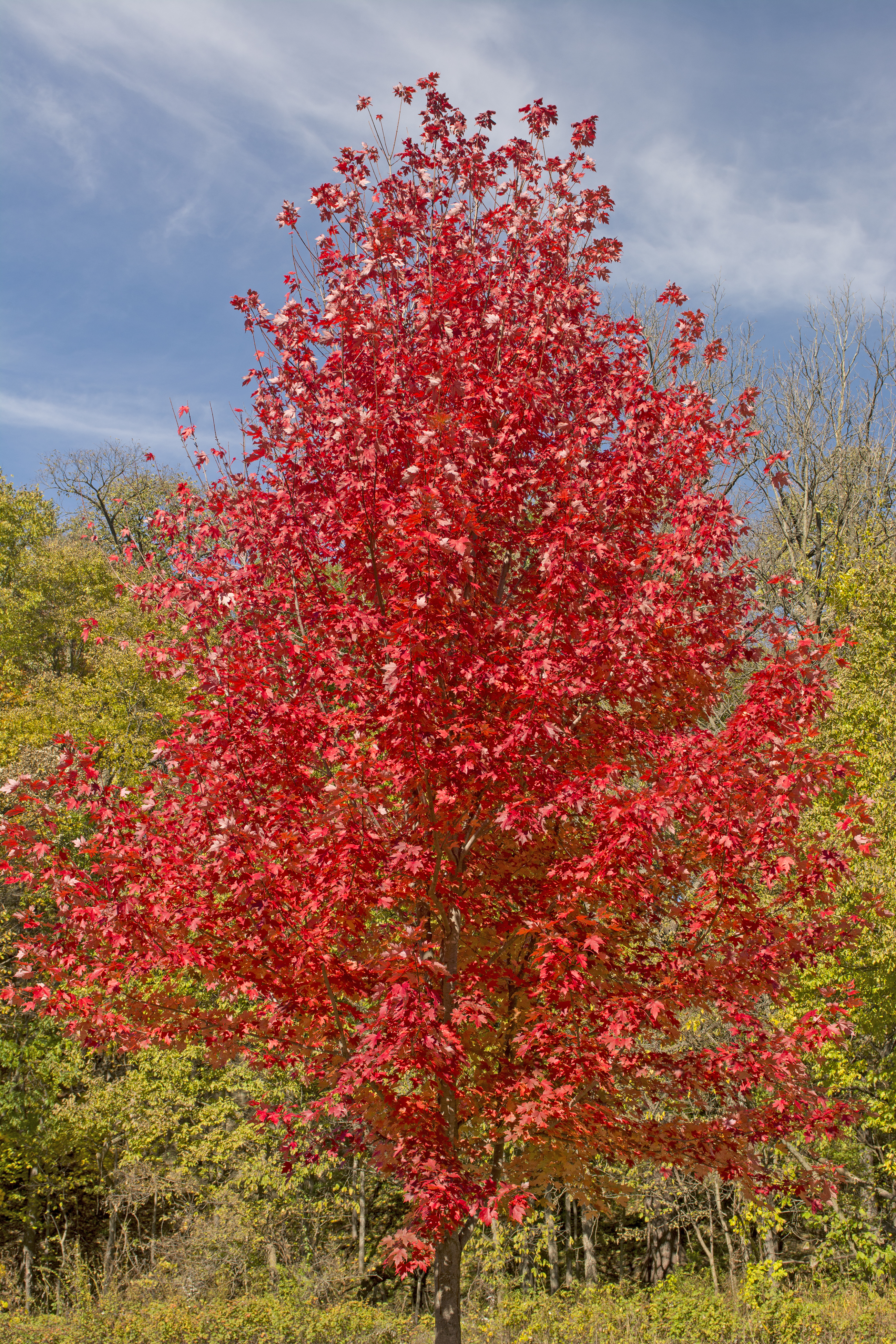
B-1090R
December 2015
landscaping:
recommended Trees for wyoming

Karen Panter & Chris Hilgert, Department of Plant Sciences

Issued in furtherance of extension work, acts of May 8 and June 30, 1914, in cooperation with the U.S. Department of Agriculture. Glen Whipple, director, University of Wyoming Extension, University of Wyoming, Laramie, Wyoming 82071.
Persons seeking admission, employment, or access to programs of the University of Wyoming shall be considered without regard to race, color, religion, sex, national origin, disability, age, political belief, veteran status, sexual orientation, and marital or familial status. Persons with disabilities who require alternative means for communication or program information (Braille, large print, audiotape, etc.) should contact their local UW Extension office. To file a complaint, write to the UW Employment Practices/Affirmative Action Office, University of Wyoming, Department 3434, 1000 E. University Avenue, Laramie, WY 82071.
Landscaping: Recommended Trees for Wyoming
Karen Panter, Ph.D., C.P.H., Extension Horticulture Specialist
University of Wyoming, Department of Plant Sciences
Chris Hilgert, Extension Master Gardener State Coordinator and Horticulture Specialist
University of Wyoming, Department of Plant Sciences
Revised from original bulletin B-1090 by Karen L. Panter and Emily E. Ewart
Editor: Steven L. Miller, College of Agriculture and Natural Resources, Office of Communications and Technology.
Graphic Designer: Tanya Engel, College of Agriculture and Natural Resources, Office of Communications and Technology.
On the coverAcer rubrumRed maple


landscaping:
recommended Trees for wyoming
The Wyoming climate is harsh, and successfully growing many landscape plants, including trees, is quite a challenge. The mountains, plains, and arid desert regions all have their own environments. These environments have an impact on the types of trees that will survive in those areas.
Site Selection
Properly placing a tree in the landscape is one of the most important issues surrounding tree survival in Wyoming. Many factors should be considered, including:
Exposure to prevailing winds.
In many places, winds blow from the west, southwest, or northwest most of the time. A tree planted in an open area on the west or northwest side of a lot or a structure will be exposed to harsh, drying, and potentially damaging winds.
Proximity to structures.
Plant trees far enough away from a structure or building so branches will not scrape the sides. The tree will need sufficient space to grow normally and naturally. Try to plant the tree at least as far away from the structure as half the tree’s mature diameter. A good rule of thumb is to plant trees at least 15 to 20 feet away from structures.
Proximity to overhead and underground utility lines.
Tree limbs growing close to power lines may cause power outages and are potential fire hazards. Use dwarf or naturally small trees if planting directly under power lines. If the area has buried utility lines, contact local authorities to determine exactly where the lines are located. Usually, there is no charge for this service.
Proximity to sidewalks, curbs, and driveways.
Plant trees at least 8 feet away from these areas. Tree roots can crack and damage concrete as the roots grow and develop.
Proximity to other trees.
If a new, young tree is planted too close to a mature tree, the new one may be shaded to the extent its growth will not be normal. Also, if new trees are planted too close to each other, their growth will not be normal. They may
Landscaping: Recommended Shrubs for Wyoming | 1

Pinus sylvestris
(Scotch pine)

2
develop tall, thin, weak branching structures and eventually will shade each other.
Exposure to sun.
Make sure the tree has enough sunlight hours to match its needs in its new home. Most trees have requirements for full sun, part shade, or shade. Make sure to place the tree in the best light for the species.
Proximity to water.
Newly planted trees must be pampered to survive in Wyoming. A source for watering must be close by, not only during the growing season but also during the winter. Wyoming frequently has periods of warm, dry weather during the winter months. Additional water at these times is crucial to the plant’s survival.
Soil pH.
Often, one of the more limiting factors in growing trees successfully in Wyoming is the soil pH. Most trees will do best when grown in soils with a pH of 6 to 7. Many of our native soils, however, have pH levels higher than 7. Select trees that will tolerate higher pH soils or more alkaline conditions.
Proximity to neighbors.
When selecting a site, take into account the neighbors. Determine if the tree will block the neighbors’ view, if it could be a possible hazard (falling or broken limbs), or if it could be a nuisance (pollen, fruit, flowers, leaves).
Purchasing Healthy Trees
Trees can be purchased in many sizes and types of containers, or in no container at all. Each container has advantages and drawbacks.
Bare-root trees.
These are usually “whips,” very small trees that may or may not have any developed branches. Whips should be purchased very early in the season before they come out of winter dormancy. The roots on bare-root
stock should never dry out, so if they must be stored, keep them in a cool, moist spot with the roots wrapped in moist peat moss or other absorbent material. As soon as possible, pot whips in new or clean containers to allow the roots to develop. Later on during the growing season, the young trees can be planted in their new homes. Bare-root trees also can be planted directly in the ground. The cost of bare-root materials is low, but they will take many years to reach maturity.
Containerized trees.
Trees can be purchased in any number of container sizes, from #1 (roughly 1 gallon) to #15 (about 15 gallons) and sometimes even larger. These trees will have well-developed root systems and will be more mature and older than bare-root trees. They also will cost more. One way to check the health of the plant is to gently remove the tree from its container. Look at the root tips – if they are clean and white, chances are the tree is healthy.
Balled-and-burlapped (B&B) trees.
Usually, the largest and most expensive trees available for purchase have their root systems contained in a relatively small “bag” that must be carefully handled. B&B trees must have their root systems intact, and the root ball should be in one piece, a characteristic called “ball integrity.” If the root ball has been pierced, the soil has fallen away from it, or the ball integrity has not been maintained, the tree’s survival will be compromised. B&B trees may require specialized equipment to move and plant.
Any tree purchased should have the following characteristics:



Site Preparation
Site preparation is probably the most important part but also the most difficult and most overlooked step of tree planting. Once the proper site has been selected for the new tree, preparing the site is next.
Preferably, the hole for the new tree should be dug before the tree is purchased or soon thereafter, especially if the plant is B&B. Dig the hole to the depth of the root ball or soil depth in the container. Trees should always be planted so the base of the plant is at or slightly above soil level. They should not be planted too deeply. The hole should be at least three times the width of the root ball.
For bare-root trees, dig the hole at least twice as wide as the extended root system. The tree should be planted only as deeply as the original soil line, which will be a darkened area at the base of the trunk. Do not amend the soil removed from the hole.
Planting the Tree
Soak the roots of bare-root trees in water for several hours before planting. When the site has been prepared, check the root system. Carefully prune out any small circling roots or
any roots that have been damaged or broken. Next, spread the roots out horizontally in the prepared hole. Carefully fill in the hole. Make sure the roots are not damaged and the tree is straight and not too deep.
If the plant is in a container, carefully remove the tree from the container either by gently pulling or cutting the container off the root ball. Always handle trees by the root ball, not the trunk. Taking care not to break or disturb the root system, gently place the plant in the hole. Make sure the crown of the plant (where the trunk and soil meet) is at or above the surrounding soil level. If the soil level needs to be raised, gently lift up the plant by the root ball, place additional soil underneath it, and then replace the plant.
If the tree is B&B, place the plant gently in the hole dug for it, making sure it is not too deep. Carefully cut away the burlap and twine from the root ball. Many B&B trees have wire baskets around the root ball instead of burlap and twine. Cut away as much of the wire basket as possible.
Landscaping: Recommended Shrubs for Wyoming | 3
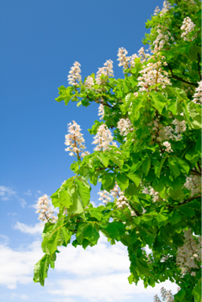
Aesculus hippocastanum(Horsechestnut)

Once the plant is set at the right level, the process of filling up the rest of the hole can begin. Make sure the tree is straight before completely filling in the hole. Gently tamp the soil periodically to fill in space under and around the root ball. Good contact between the soil and the root ball is essential. Roots cannot grow in pockets of air.
When the hole is filled all around the root ball, build a low “wall” around the perimeter of the hole to hold in water. The next critical step is watering the plant. The idea is twofold: settle the soil in around the root ball and provide water for the root system.
A slow trickle of water over several hours is one way to water the plant. Make sure, however, the hose is moved periodically so all areas around the root ball are watered. A sprinkler is also effective in watering. Use a gentle sprinkle to water the tree gradually over a few hours. The idea is to settle the soil around the root ball without compacting it.
Maintaining the Young Tree
After planting, do not fertilize the new tree. The tree may need to be staked, especially in windy areas. Place two to three metal stakes around the tree, away from the root ball. Always use wide cloth or nylon straps around the trunk of the tree so as not to damage it. Gently tether the tree to the stakes so it can move to a degree but will not fall over.
Also after planting, carefully prune off any dead or broken branches. The pruning cut should be made just outside the branch collar and not flush with the tree trunk. After removing dead or broken branches, further pruning should not be needed the first year.
Water the new tree frequently during the growing season. The area around the roots should be moist but not waterlogged. The tree’s roots should not be allowed to dry out.
Winter watering is essential, especially for young trees, because Wyoming winters are unpredictable at best. Snow cover cannot be counted upon to provide consistent water
4
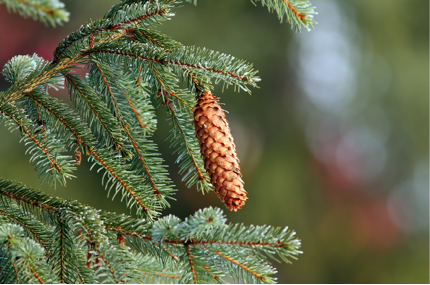
Picea abies
(Norway spruce)



Landscaping: Recommended Shrubs for Wyoming | 5
during the winter. Watering trees and other perennial plants is very important during warm, dry periods.
Trees will survive Wyoming winters much better if their root systems are kept moist during the cold months. If the ground is frozen, do not water because it cannot penetrate the soil; however, if the area is dry and there is no snow cover, it would be beneficial to get out the hose.
Guide to Recommended Trees for Wyoming
The following trees have been grown successfully in various parts of Wyoming. Hardiness and adaptability of woody plant species is closely associated with altitude. Each species is identified with a USDA hardiness zone and a maximum elevation for growth. This table is not intended to be an all-inclusive list. A local nursery professional may have other suitable trees for each area.

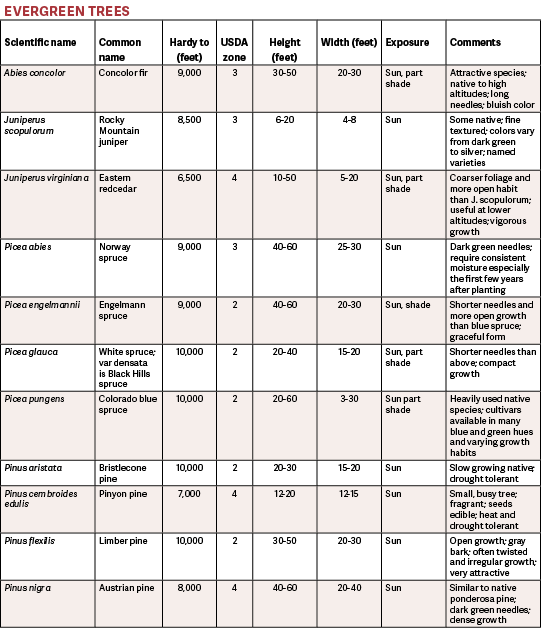


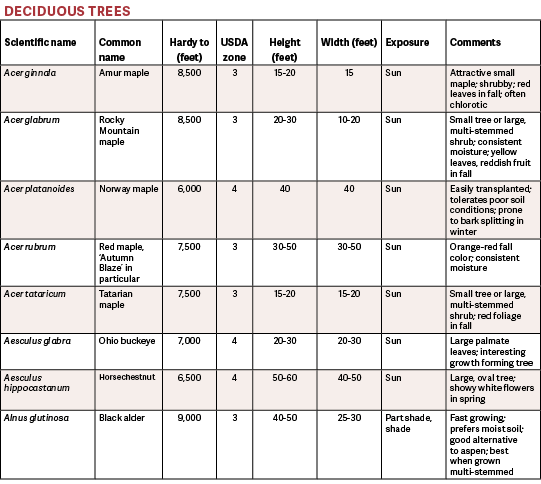

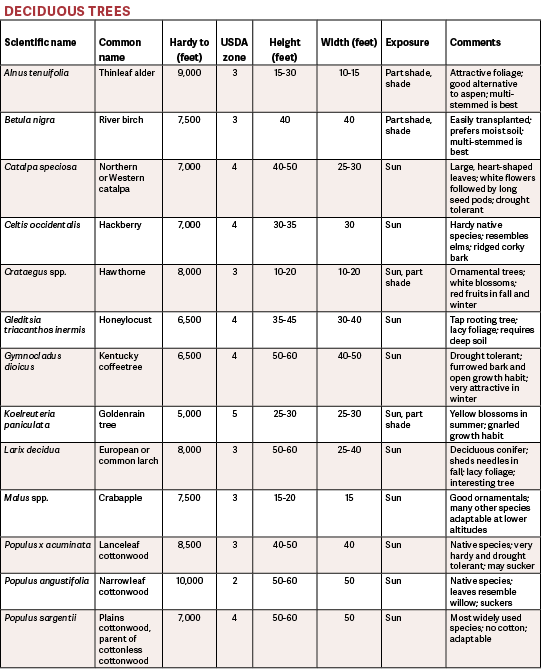





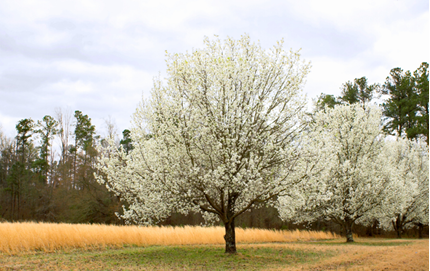
Pyrus calleryana (Ornamental pear)